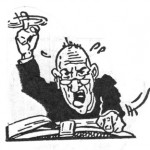 Churches are peculiar places. I have had the opportunity to serve a few of them. Some of my pastoral experiences have been awesome and rewarding – baptisms, weddings, the transformation of individuals and families. Some other experiences have been about as much fun as a sharp stick in the eye. And the churches which I have served have met in a diverse number of places: In the hollow of a school gymnasium; in a leaky storefront on the wrong side of the tracks; in a multi-million dollar sanctuary with all the technological bells and whistles; in an old redbrick church so old it barely escaped the fires of General Sherman’s army. In fact, some of the deacons in that old redbrick church may have served in Sherman’s army. Speaking of a sharp stick in the eye, they certainly had the attitude and constitution for it. But I digress.
Churches are peculiar places. I have had the opportunity to serve a few of them. Some of my pastoral experiences have been awesome and rewarding – baptisms, weddings, the transformation of individuals and families. Some other experiences have been about as much fun as a sharp stick in the eye. And the churches which I have served have met in a diverse number of places: In the hollow of a school gymnasium; in a leaky storefront on the wrong side of the tracks; in a multi-million dollar sanctuary with all the technological bells and whistles; in an old redbrick church so old it barely escaped the fires of General Sherman’s army. In fact, some of the deacons in that old redbrick church may have served in Sherman’s army. Speaking of a sharp stick in the eye, they certainly had the attitude and constitution for it. But I digress.
Here is one of the things that make churches peculiar: The most heated arguments in the church were not over our location or theology or future plans. No, the worst controversies I ever endured were over our style of worship. Should we use hymnals or modern worship music? Should drums be allowed in the sanctuary? Is it blasphemy to move the pulpit to accommodate the children’s choir? What would happen if someone clapped or raised their hands during the solo? These are the questions that send the pastor scurrying to his or her gastrologist.
See, with all these exotic locals came an equally exotic variety of worship styles. I’ve preached after a stately anthem performed by robed choir members and pipe organs. I’ve tapped my foot and clapped my hands to the cranking riffs of old hippies with electric guitars. I’ve listened closely to the tight four-part harmony of southern gospel. I’ve worn a suit and tie to church; I’ve worn shorts and sandals. I’ve delivered time-honored three point sermons with a poem and a prayer; and I’ve preached with the technological assistance of projectors and PowerPoint. I’ve witnessed the traditional Easter cantata; and I’ve even seen a few interpretive dance steps across the church podium. And all this worship diversity was in a single strain of the Protestant tradition! This doesn’t account for the truly wild multiplicity of worship expression that stretches across the Christian sphere from the Pentecostals to the Presbyterians. Praise the Lord and pass the Pepcid.
Which of these styles is “right?” I don’t presume to know. Our form of worship will always be dictated by our traditions, our culture, and our context. A look at how Christians from other countries worship proves this point. “Which worship style is right” is, after all, the wrong question. The better question is this: “Does our worship push us out of our church sanctuaries (or wherever it is we meet) to be Christ to the world?” In other words, “What happens when the worship service is over?” This is the more appropriate question.
If our worship moves us past ourselves to the risen and redeeming Christ sent to love the world, then the worship is “right.” If our worship sends us into the community as the Father sent his own Son, then it is empowered with spirit and truth. But if our worship focuses us, even in subtle ways, on ourselves, then it is selfishness at best and sacrilege at worst. It isn’t worship at all.
The final words of the old Latin mass were, Ite missa est – “Get out!” The priests who daily invoked these words over their congregations understood worship’s purpose. When the last song is sung, the last prayer offered, and the last homily delivered, the goal of all worship is to redemptively and missionally leave the sanctuary in service to others. So, take your pick: Sermons or liturgy; southern gospel or rock and roll; drums or pipe organs; corporate prayer or contemplation; kneeling benches or mosh pits. But if these things do not translate into loving action in the community, if these things do not force us out of the building and out to others, we aren’t being worshipful at all. Does worship style matter? Sure it does. But worship substance matters all the more.

